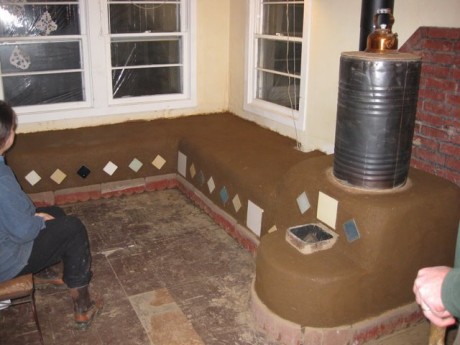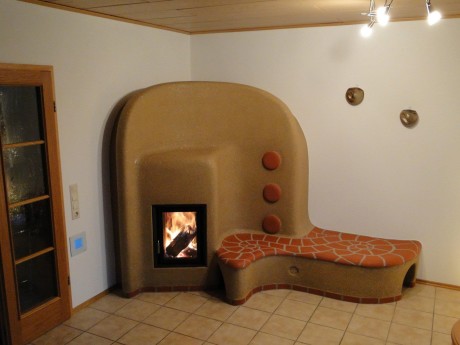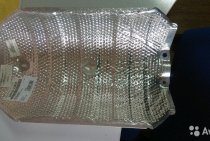Furnace classification
People have long noticed that with strong heating, clay from a soft material turns into an impenetrable stone. No one now remembers when the first kiln for firing clay products appeared. Over the millennia of human activity, not only pottery, but also the furnaces necessary for it, have constantly developed and improved.
Such a furnace will help to make handmade ceramics
There are several main categories of kilns:
- by the type of fuel or energy source on which the unit operates. This section highlights gas, electric and solid fuel;
- according to the location of the heater. There are two main types: muffle, when the heaters are placed around the muffle, and chamber - the heater is inside the firing chamber;
- difference in the type of chamber environment. This classification is divided into three types: vacuum, when air is pumped out of the chamber, air - conventional furnaces, and with a protective gas environment, when auxiliary gas is pumped in for better processing of products;
- loading differences. Three categories: tubular - loading from above, for uniform firing of artistic products, bell-type - the same loading, but for dimensional objects, horizontal - when loaded from the front;
- power and maximum heating temperature. The final quality and color of the product depends on the firing temperature, so this category is of great importance for those who experiment in these areas.
Overview of ceramic kilns:
Construction of a summer stove
The interior structure is most often built of adobe bricks or blocks. But with the help of layers of adobe, you can do it yourself, for example, a summer or, as it is also called, an outdoor stove.
The algorithm for constructing a street structure from adobe is as follows:
- Prepare the base for the future furnace design. To do this, you can use an ordinary whole brick, which must be laid out in a semicircle, and the inside can be filled with broken brick, glass or other material. For the hearth you need to use fireclay bricks.
- Mix clay with straw (preferably cut) and sand in a large container (you can use a used bathroom). It is best to do this with bare feet, while making sure that the resulting mixture is viscous and homogeneous.
- On the finished base, using wet sand, create a form for the future structure, on which to mark the entrance. Usually, it is built hemispherical, and wet sand is ideal for creating such a shape.
Lay the adobe on, under, or around the mold. After that, they gradually put the building material on the previous layer and slowly move towards the top. It must be remembered that the higher the sand dome, the thinner the masonry should be, otherwise the structure may “float”.
Everything, the structure is done, and you need to wait until it dries, after which you need to smooth it a little with a trowel. This technique will protect the structure from sticking to it with dry grass, leaves and other debris. If the structure becomes more or less dry, then from its inside you need to select sand, which has already played a role. It is also recommended to light small fires inside the dome so that the building dries out faster. It is possible to build an adobe oven with a chimney, and an option is also possible without it.
Thus, an adobe stove is not just a building structure, but, one might say, a part of our history, one of the oldest Russian traditions, if you like. And this is indeed true. Therefore, let's respect our history, our customs, multiply our traditions, and then everything will be fine with us. We are convinced of this! published by econet.ru
If you have any questions on this topic, ask them to specialists and readers of our project here.
clay oven
Clay ovens have been built for centuries, since there were no bricks in the villages before or they were too expensive. At present, it is almost a forgotten art. We made our oven, relying on our own intuition and information gleaned from books, we also had no experience in this matter.
Our stove is a Russian stove "in black", that is, without a chimney. Such stoves used to be placed in the so-called "chicken" huts, where the smoke went into the room, and then out through a small window near the ceiling. Over time, the window was replaced with a chimney - a wooden pipe starting from the ceiling. In huts, such stoves could occupy up to 1/4 of the area of \u200b\u200bthe room. Our furnace has dimensions of 1.2×1.6 m. The names of the main parts and dimensions are shown in fig. one.
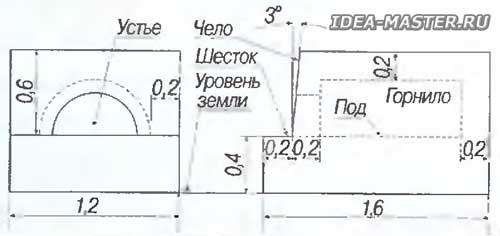
Before the construction of the furnace, it was necessary to make a foundation for it. To do this, we removed the sod and the upper soft layer of soil to a depth of 20-25 cm on the site. The bottom of the pit was filled with liquid clay mortar, boulders were laid and they were also filled with clay mortar. Then, formwork was installed around the pit and the masonry was raised 20 cm above ground level. The top of the masonry was leveled with a thick clay mortar and a layer of waterproofing material was laid (Fig. 2). Any material is suitable for him: roofing felt, plastic wrap, old bags. In the old days, birch bark was used for this purpose.

On the waterproofing, we laid two layers of boards 25 mm thick crosswise with an overlap. Due to this, the load from the furnace is evenly distributed over the entire foundation.
After the foundation of the furnace was laid, they proceeded to the construction of the hearth and hearth. To do this, stones were laid out over the foundation to a height of 20 cm and tied with clay mortar, and the upper 5 cm of these 20 cm were laid only from clay. If the layer of clay is thinner than 5 cm, then when heated, it will fall off the stones and there will be pits on the hearth.
A few words about clay
For a clay oven, a properly prepared clay solution is the most important thing. The mortar must provide minimal shrinkage and at the same time be durable. It is made from clay, sand, water. The more sand, the less shrinkage, but the lower the strength. The clay/sand ratio depends on the fat content of the clay used. There should be very little water in the solution, again to reduce shrinkage.
In our case, the situation was simplified, since we had no sand at all in the forest clearing. I had to do everything from clay "as it is." The clay was taken out of the pit and transferred to a 1.5 × 1.5 m shield, where, with a small amount of water, it was stirred with feet to the consistency of a stiff dough.
External and internal formwork was installed on the hearth. The outer formwork consists of four plank walls knocked together into a box with overall dimensions of 0.6 × 1.2 × 1.4 m. The internal formwork is shown in fig. 3.
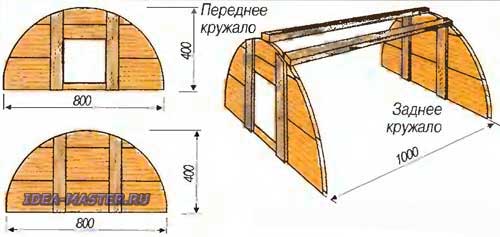
A hole 20 × 20 cm was left in the front circle. It was needed later, when burning the formwork. The outer formwork was wedged with stakes so that it would not deform when the clay was packed. The hole in the front circle was closed with a piece of board from the outside. Then the inter-formwork space was filled with clay.
Clay was laid in layers of 10 cm and carefully compacted. To increase the strength of the structure, we reinforced the corners, the overlap of the vault and the mouth with rods Ø10 mm. Even if the clay cracks, the rods will not let the stove fall apart. At the same time, we took into account that the mouth would be cut in the front wall of the furnace to a height of 32 cm and the rods should be 10 cm higher. The same was done with the ceiling of the furnace. The rods were placed 10 cm above the inner formwork.
Advantages and disadvantages
In modern times, people have again begun to show interest in the original Russian adobe stove. They are built not only in rural-type settlements, but also by people living in the city. Equipment can be erected on the street or right in the house.
Clay stoves are used not only as a heating unit, but also as a decorative element that can be used to decorate a garden, a country house and similar buildings. The design is very simple, so it will not be difficult to recreate it in any room. For manufacturing, you only need to have a great desire to build, as well as clay.
The furnace is gaining great popularity due to its obvious advantages:
- Maximum ease of construction - there is no need to spend money on expensive materials and tools. The design is created by hand and does not even have to use electricity.
- Compact dimensions.
- Full environmental friendliness - only natural materials that do not pollute the environment are used for the furnace and manufacturing.
- Little cost. You don't have to buy anything at the hardware store. Even on the sand there is an option to save money - go to the nearest beach and dial the right amount there.
- Great practicality. The oven is used not only for heating, but also for cooking, drying clothes. It is also a good decorative element.
Despite the large number of advantages, any device has its disadvantages. The only downside is that it will take a lot of building material - clay. It must be mixed properly to get the right consistency. But if you conduct a few experiments and practice mixing a small amount, then there will be no difficulties in this situation.
How to make a clay oven
Clay should be quite plastic, with a minimum moisture content. The solution should provide minimal shrinkage, while being strong enough. The ratio of clay and sand is 1:6
In this case, it is necessary to pay attention to the fat content of clay. The mass must be thoroughly mixed, this will take time
And under favorable conditions and following the technology, you can build a furnace with your own hands in one day. With each firebox, the stove becomes stronger, which ensures the solidity of the structure. Tools needed to make an adobe oven
- beaters, which are wooden cuttings with knobs;
- chekmari - large wooden hammers;
- rammer - used for kneading clay;
- excess clay is removed with a knife;
- the pestle is used for laying mortar;
- grater and scraper - for leveling the walls.
Clay Kiln Construction Technique
There are two technologies for kiln construction from clay. In the first case, formwork is used, and in the second, a do-it-yourself adobe oven is formed from pre-prepared blocks. The first option is complex and more suitable for small hearths intended for baking bread and cooking baked dishes, while the second can be used to build a functional Russian oven.
Clay mortar preparation
Clay, sand and water are required to prepare the solution. In many regions, all this can be found absolutely free. For construction, oily clay of a reddish hue is best suited. Red granular clay is not suitable for ovens. If self-extraction of raw materials is difficult, then it can be bought at hardware stores. It is more profitable to buy in large packaging - it's cheaper.
There is no exact recipe for the solution - the proportions depend on the fat content of the clay. In some areas sand is not added at all, while in others it is required twice as much as the main raw material. The output should be a very dense and thick homogeneous solution.
Baking in the formwork
It was not by chance that the adobe oven was named - the construction technology involves beating the solution that fills the formwork with special wooden hammers. One end of the tool is flat - they compact and level the surface, and the other has a wedge-shaped shape and serves to beat the clay between the formwork.It will not work to build such a hearth alone - in the old days, neighbors were involved in the work, assembling teams of 15-16 people.
Formwork for baking
The manufacture of formwork is not an easy process, it is assembled from wood during the formation of the furnace, but all the details are prepared in advance. The most difficult thing is to correctly make the “created” for the firebox. The furnace billet has the shape of half a barrel, while the arch of the arch starts from the base and does not have straight walls - this enhances traction and provides good heat. The boards are sawn from the inside and tied to the details of the rope, so that after drying it is easy to remove the shape.
Clay oven in a modern version
Before placing the clay solution in a wooden "shirt", clay is beaten in small portions on the floor to get rid of lumps and voids. After filling the form, the top layer is covered with pieces of clay 30 * 40 cm in size and cover the top. After three days, the struts are removed, the mouth is cut out with a knife and the front boards of the work are knocked out. The upper formwork is carefully removed and covered with an error solution. At will, stoves are cut out on the walls, which collect heat and decorate the hearth. You can think about the first firebox no earlier than in 2 weeks.
Construction of a clay block stove
To build a clay oven with your own hands from blocks, first make homemade bricks. To do this, the solution is kneaded for a long time, achieving a uniform composition and a dense layer. In the old days, they did it with their feet and with the help of horses, later they pressed the clay with a tractor, and now they use all kinds of devices.
A well-packed clay layer is chopped with an ax into blocks of the desired size, without waiting for drying. A stove is built from the blocks, but no mortar is used to bind the bricks, but the joints are rammed with hammers. To get the firebox of the desired shape, a wooden formwork is made, which can not be removed, but burned during operation.
Stylish clay oven in a modern interior
It is allowed to make a fire only after the final drying - after two weeks. In the first few days, small portions of brushwood are burned to dry the clay and give it strength. Over time, a clay oven only becomes stronger - the raw material is baked and turns into a monolithic structure.
What are the methods for creating clay ovens
A do-it-yourself adobe oven can be built in two ways:
- With formwork. This option was used in cases where it was necessary to build a small hearth, with which it was possible to bake bread, cook baked dishes.
- With the use of clay bricks or formed blocks. Such designs ensured the versatility of Russian stoves.
Clay in the formwork
The first option is more complex and requires more time and solution. Therefore, we will first dwell on this option - very reliable and cheap, but more complex.
Let's consider how the oven is built "in a black way", which is placed in the garden, near a room or in some other place on the street. Clay oven for baking bread has the following external dimensions: 0.6x1.2x1.6 m.
The waterproofing area must then be covered with two layers of boards (25 mm) crosswise, which will contribute to an even distribution of the load on the base of the structure.
For the construction of a hearth and a hearth, at a height of about 20 cm, a certain number of stones are laid out, which are filled with not very liquid clay, while its layer above the stones should be about 5 cm.
Internal formwork
After that, they are engaged in the installation of external and internal formwork (see Fig.). The structure of the external structure is simpler: a box measuring 60x120x160 cm.
The inner formwork can be clearly seen in the figure. The front circle is equipped with a hole of about 20x20 cm, which is useful in the process of burning the formwork.
To avoid unnecessary deformations, the outer part is wedged with pegs. After that, it is necessary to fill the space between the formwork with previously prepared clay.
To improve the quality of the structure, it is necessary to lay the clay in low layers (up to 10 cm) and ram it well.
In order for the whole structure to be strong, the corners and the vault must be reinforced with 10-12 mm rods. Also lends itself to reinforcement and the mouth, which will have a height of approximately 32 cm.
Clay block oven
The second method was most often used by rich people who could purchase bricks or blocks for the construction of a furnace.
Today, clay blocks or bricks can be made by hand. For this purpose, it is necessary to knead the clay solution until a homogeneous composition and a dense layer are obtained, after the formation of which, it must be cut into blocks of a certain size. With such elements and build a stove.
It should be taken into account that during the creation of the structure, no mortar is used to bind adobe bricks together. The joints between them must be tamped with hammers.
To give the firebox a specific shape, they use home-made formwork, which is burned inside the structure 2-3 weeks after construction during the first “idle” operation. It means that before full-fledged operation, it is necessary to light a small fire with brushwood several times inside so that the whole structure gradually dries completely.
